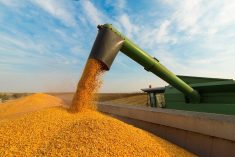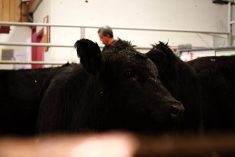Western Canadian feeder cattle markets were relatively unchanged from week-ago levels. Feeder cattle numbers are declining at this time of year, so those buyers looking to secure ownership had to be more aggressive.
Higher-quality packages were available in Saskatchewan, which traded at a small premium to Alberta markets. In central and southern Alberta, there appeared to be a wider price range amongst smaller groups with various features. Fleshier cattle tend to trade at larger discounts in the summer months. Buyers were quick to back away from late bloomers off backgrounding operations.
Read Also

U.S. grains: Corn and wheat futures firm on brisk exports, softer dollar
U.S. corn and wheat futures firmed on Thursday, supported by brisk export sales and a softer dollar, which tends to make U.S. grains more competitive globally, analysts said. Soybean futures clung to modest gains.
In central Alberta, a small group of fleshier mixed steers averaging 855 lbs. were quoted at $171. In eastern Saskatchewan, larger-frame medium- to lower-flesh 800- to 825-lb. steers traded in the range of $188-$193 while larger-frame medium-flesh heifers weighing from 800 to 825 lbs. were quoted from $166 to as high as $170.
The steam appeared to fizzle for the lighter weight categories. The crowd shopping for grassers has come and gone; therefore, feedlot operators were the only buyers for calves this week. In central Alberta, a small group of black steers weighing just under 650 lbs. traded for $215. Medium-frame 550-lb. black steers were quoted at $221. Small groups of steer calves in the weight range of 600-630 lbs. traded for $203-$208 in southern Manitoba; however, in east-central Saskatchewan, steers weighing 600-650 lbs. were traded from $225 to as high as $232.
Corn and barley prices continue to soften and there appears to be an optimistic bias for fed cattle prices in the final quarter of 2018. On the flipside, adverse trade rhetoric between Washington and Beijing continues to overshadow grain and livestock markets. The uncertainty over trade has caused some buyers to remain on the sidelines. This risk sentiment was elevated in certain regions of Western Canada, which contributed to the wider price range in the lighter weight categories.
— Jerry Klassen manages the Canadian office of Swiss-based grain trader GAP SA Grains and Produits Ltd. and is president and founder of Resilient Capital, specializing in proprietary commodity futures trading and market analysis. Jerry consults with feedlots on risk management and writes a weekly cattle market commentary. He can be reached at 204-504-8339.
















